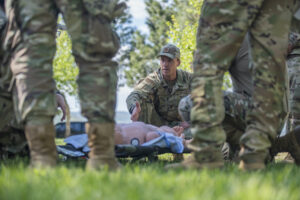
Story by Master Sgt. Becky Vanshur
124th Fighter Wing
Airmen from the Idaho Air National Guard’s 124th Medical Group traveled outside of familiar ground, to train in a field environment near Little Camas Reservoir in Elmore County, June 5-8, in preparation of future deployments.
“The intent for this field training was to get the entire medical group exposed to the field environment for deployment readiness, as well as pushing comfort zones and team building,” said Maj. Mark Urban, critical care air transport team physician.
Approximately 65 medical personnel practiced treating and stabilizing casualties using tactical combat casualty care in a simulated deployed location while defending medical structures and personnel and becoming familiar with survival skills.
The Airmen were trained on Survival, Evasion, Resistance and Escape skills from Master Sgt. Raymond Perez, 124th Fighter Wing SERE specialist. His goal is to prepare the U.S. military personnel to be able to survive in intense situations in unfamiliar surroundings.
“The medical teams will be geographically separated from the hospitals while deployed, functioning from a forward operating base,” said Perez. “I am training them on personal protection, clothing, building shelters, building fires, mental and physical health, environmental safety and protection, water purification and food sustenance. We are going to find food in the area, anywhere from vegetation on the ground, to hunting animals that we will cook and eat.”
Medical personnel focused on TCCC, point of injury, patient packaging, calling in a 9-Line medevac, patient movement, ground treatment and prolonged field care while Perez trained them on map and compass skills, signaling and recovery and making ground-to-air signals with flares for air rescue.